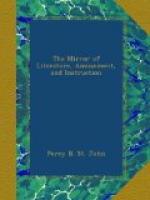“I purchased a magnificent collection of pictures by Vandyke, Rubens, &c. The marbles are not equalled, perhaps, in the kingdom. I made a noble approach to the castle through a solid rock, built a porter’s lodge, and founded a library full of books, some valuable and scarce, all well chosen. I made an armoury, and built walls round the court and pleasure gardens. I built a noble green-house, and filled it with beautiful plants. I placed in it a vase, considered the finest remain of Grecian art, for its size and beauty. I made a noble lake, from 3 to 600 feet broad, and a mile long. I planted trees, now worth 100,000l., besides 100 acres of ash. I built a stone bridge of 105 feet in span, every stone from 2,000 to 3,800 lbs in weight. The weight of the first tier on the centre was estimated at 1,000 tons. I gave the bridge to the town with no toll on it. I will not enumerate a great many other things done by me. Let Warwick Castle speak for itself.”
STANZA X.
There is a feeling of respect inspired by ancient buildings of importance. Such a castle as Warwick, which has lodged a succession of generations of the most opposite characters—at one time the “dulcis et quieti animi vir, et qui, cougruo suis moribus studio, vitam egit et clausit;” at another by the assassin of Piers de Gaveston, the king’s favourite, “whose head he cut off upon Blacklow Hill, and gave the friars preachers the charge of his body, inasmuch as he had called the said earl the Black Dog of Arderne”—is not to be approached as one visits a handsome stone house of Palladian architecture!—such a house we know can never have been the scene either of council or conspiracy; within such walls there can never have been “latens odium inter regem et proceres, et praesecipue inter comitem de Warwick et adhaerentes ejusdem.”
As to the river and its swans. I have learned from the bard to whom it has been long since consecrated, (although he may not have had the right of fishing in it when alive,) that “discretion is the better part of valour.”
If I were to describe the walks, I should only say that they were contrived, as all walks ought to be, to let in the sun or to shut him out by turns. Here you rejoice in the fulness of his meridian strength, and here in the shadows of various depth and intensity, which a well disposed and happily contrasted sylvan population knows how to effect. The senatorial oak, the spreading sycamore, the beautiful plane, (which I never see without recollecting the channel of the Asopus and the woody sides of Oeta,) the aristocratic pine running up in solitary stateliness till it equal the castle turrets—all these, and many more, are admirably intermingled and contrasted, in plantations which establish, as every thing in and about the castle does, the consummate taste of the late earl, although it must be admitted he had the finest subjects to work upon, from the happy disposition of the ground.




